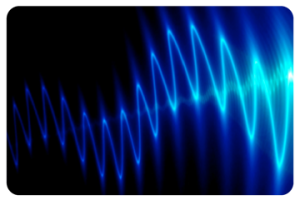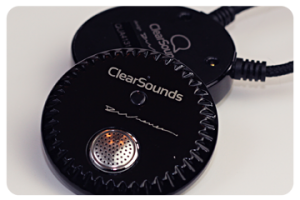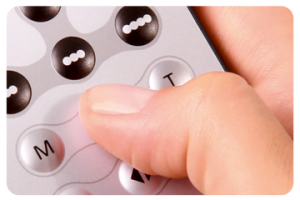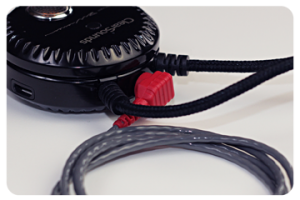UNDERSTANDING
BLUETOOTH
Bluetooth® is a low-power, short range technology that wirelessly connects cell phones (or MP3 devices, PDAs, computers, etc.) to a compatible receiver.
Are there Bluetooth hearing aids (or cochlear implants)?
A full implementation of the Bluetooth standard requires a greater power supply than can be generated within the small footprint of a hearing aid (or cochlear implant) battery, so “bluetooth hearing aids (or CIs)” are not currently widely available on the market. However, manufacturers of wireless hearing aids long ago created a clever solution for accessing this prevalent wireless standard. Wireless hearing aids (and CIs) can use compatible assistive listening devices, often called streamers, to provide a communication link between the wireless technology in the hearing aids and any Bluetooth-enabled device. (1)
How does Bluetooth work with MED-EL processors?
AudioLink is an easy-to-use universal connectivity device that can connect your SONNET or SONNET 2 to your phone, tablet, TV, and all your other favorite media devices. It features easy access to controls, various mixing modes for optimal listening, wideband audio Bluetooth for cell phone use, TV connectivity and an audio input for multimedia use.
Other third-party devices are available that can transmit the bluetooth signal via headphones, a telecoil accessory, and/or audio cable. ARTONE MAX is a good example of how a third-party Bluetooth device can work with MED-EL's processors and hearing aids with built-telecoil. The ARTONE device is paired with the Bluetooth-enabled device (tablet, laptop, MP3 players, phone, etc.) and then receives the signal from that device. The ARTONE acts as a "receiver" that captures the Bluetooth signal from the paired audio device and then delivers that sound via headphones, telecoil, or audio cable.
The use of a "universal" product like ARTONE allows bi-modal users with a hearing aid or cochlear implant on their other ear to hear simultaneously -- in "stereo." Oftentimes products from manufacturers like Phonak or Oticon may ONLY work with their brand of hearing aids and are not compatible with most cochlear implants. By using a Bluetooth/telecoil device like the Artone, most hearing devices with telecoil can benefit from Bluetooth technology.
-
![]()
 Although you often must carry an additional device in order to access your mobile phone or music player, a "streamer" provides many opportunities for enhanced listening experiences.
Although you often must carry an additional device in order to access your mobile phone or music player, a "streamer" provides many opportunities for enhanced listening experiences.The audio signal from the paired device can be amplified and its volume may be controlled by the streamer or using the FineTuner, depending on the streamer's design. There are no wires connected directly to the audio device which provides better comfort and mobility for the user. MED-EL users have the options of using "T" or "MT" settings to suit their desired listening environment. When using a phone, the streamer provides a hands-free solution.
-
![]()
 Products like Clearsound's Quattro offer a detachable microphone that can be placed at a sound source up the 30 feet away. Different than other Bluetooth devices, it provides a built-in "FM system" -- which simply means having both a transmitter and receiver component as part of a system.
Products like Clearsound's Quattro offer a detachable microphone that can be placed at a sound source up the 30 feet away. Different than other Bluetooth devices, it provides a built-in "FM system" -- which simply means having both a transmitter and receiver component as part of a system.Quattro users can remove the microphone and place it near a speaker (i.e., presentation, worship, lecture, or even in a restaurant). The microphone will then transmit the sound to the receiver worn around the neck. From there, the sound is transmitted via headphones, telecoil, or audio cable.
-
![]()
 After pairing the Bluetooth accessory with your audio device (phone, tablet, laptop, etc.), position the neckloop around your neck. Select "T" or "MT" on your remote to activate the telecoil.
After pairing the Bluetooth accessory with your audio device (phone, tablet, laptop, etc.), position the neckloop around your neck. Select "T" or "MT" on your remote to activate the telecoil.Most Bluetooth accessories have a volume control, but you can also turn up the volume on your audio device that you are connected with. Volume can also be adjusted on your processor by using the remote.
For more information about telecoil, click here.
-
![]()
 Products like the Quattro may come with headphone jack.
Products like the Quattro may come with headphone jack.This jack is primarily designed to connect standard earbuds or headphones. Telecoil is subject to interference in certain listening environments, and this gives the user an added option to use headphones instead.
For MED-EL users, the headphone jack allows for connecting with an audio cable. Simply plug an audio cable into the headphone jack of the Bluetooth device – and connect to the FM Sleeve or Mini-Battery Pack.
(NOTE: "T" or "MT" is NOT used with audio cables.)






